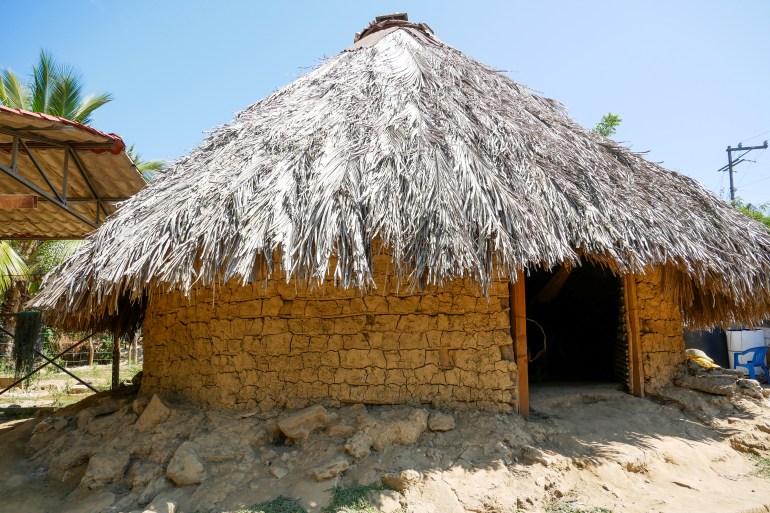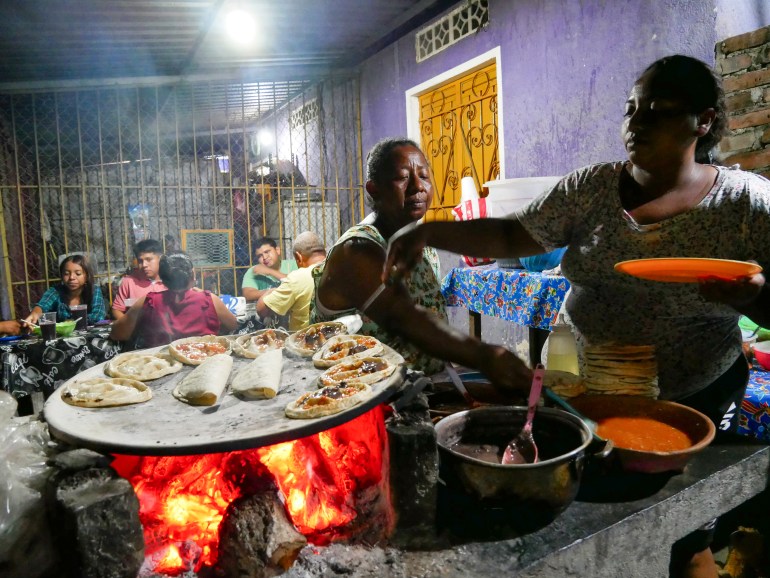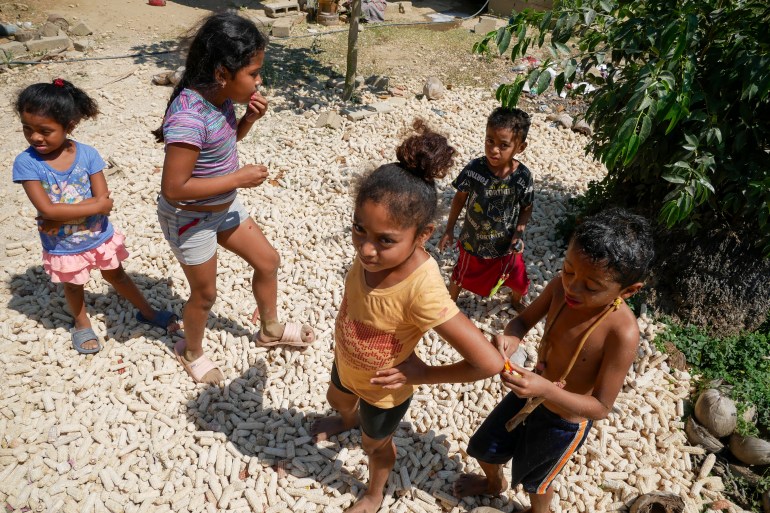[
oaxaca, mexico – Outdoors Mama Cointa's home, the place she lived virtually her complete life, friends have gathered to have fun her one hundred and first birthday. Her buddy Victor controls her trembling hand along with his whereas she bends a bouquet of withered flowers wrapped in ribbon to her nostril. His son Don Amado takes guests contained in the household residence.
“Our home is the final certainly one of its sort right here,” Amado stated, crouching beneath a sheet of palm leaves hanging on the entrance of the windowless, one-room home the place he was raised by his mom, his maternal uncle. Cointa” by Chávez Velazco. , within the village of Tecoyame, Oaxaca.
“However it could not occur round subsequent yr. There isn’t a assist to assist us, no cash to keep up it because the local weather turns into extra excessive and we’re extra threatened,” Amado stated, earlier than stealing a look at his mom, whose milky blue eyes A flood of tears has began coming.
“Now we have forgotten.”
Generally known as “El Redondo”, Mama Cointa's residence symbolizes the Costa Chica, the “little coast”, which stretches about 400 km (250 mi) throughout two states spanning the Pacific Ocean. Extra Afro-Mexicans dwell right here than anyplace else on this nation of about 130 million folks. Lengthy and harsh dry seasons lately have prompted intense drought in Tecoyame and surrounding cities, inflicting the land to harden and crack and the dry soil to turn into unable to soak up the water of Mexico's wet season. Is. As a substitute, rainwater erodes the concrete-like floor, splashing onto village properties and weakening their foundations.

Constructed of mud and sand with round partitions and a cone-shaped roof tied with vines, palm fronds and picket beams – one of these home was first in-built Mexico by African slaves delivered to Mexico by Spanish conquistadors within the sixteenth century. Was created.
A portion of them escaped the shackles of slave homeowners, and fled quickly by means of the wooded and hidden hills that characterize Mexico's huge Pacific coast. Settlements like Tecoyame, just some kilometers from the seashores the place slave ships landed, have been constructed solely with supplies that have been accessible on the time, and homes like Mama Cointa have housed Mexicans of African descent for lots of of years. Has offered shelter to generations.
“El Redondo in Tecoyame is an emblem of the essential African heritage right here, as are meals, dance and music,” native historian and hospitality supervisor Victor Guzman instructed Al Jazeera. “They’re concrete examples of the historical past, struggling, evolution and identification of the Afro-Mexican folks.”
Discovery of Mexico's 'Black Pearl'
Guzmán lives 30 km (19 mi) north of Tecoyame in Cujinquilapa, one of many largest cities on the Costa Chica. It’s residence to 27,000 folks, 75 p.c of whom determine as African-Mexican. Cujinquialpa is a metropolis that’s no completely different from every other metropolis in Mexico. Erased from vacationer journey guides years in the past and unknown to most Mexicans, this metropolis is self-made, self-contained and boldly proud.
Locals name it the “Black Pearl” of Mexico, and like a treasured gem, Cujinquialapa’s uncooked magnificence is pure and unpolished, created by the individuals who dwell there. It has been surrounded and remoted for many of its historical past, however not by selection.
With spicier meals and extra pungent flavors than conventional southern Mexican delicacies, cujinquialapa has a robust culinary identification, rooted in African staple meals, and the indigenous cooking strategies and elements native to the Mexican states of Oaxaca and Guerrero. Is mixed with.

Fried plantains served with condensed milk are sometimes served with spicy, red-colored fish stew, fried corn pancakes or “sopes” with slow-cooked pig's cheeks and tamales de tichindas, mangrove mussels combined with corn flour. And it’s eaten wrapped in banana leaves.
As a result of proximity to the ocean, fish is the centerpiece of the group's weight-reduction plan. It’s purchased domestically each morning at dawn within the seaside market, which resembles an public sale, and is positioned on the sting of an untouched seashore, a brief distance from Cujinikuilapa. Black fishermen catch lots of of kilograms of shiny, colourful Pacific fish within the early morning, and take them to the central market of Cujinikuilapa, the place it’s weighed.
What shouldn’t be purchased there’s given as cost to younger fishermen studying the commerce, and the rest is offered to recent seafood eating places in widespread vacationer locations corresponding to Acapulco and Puerto Escondido, typically at a five-fold markup.
Along with the meals, the world-renowned “satan dancers” credit score Cujinikuilapa as the house of their ceremonial dances. Just like the native delicacies, the origins of the “Danza de los Diablos” lie in slavery, when the dance was carried out as a prayer to the African deity Ruza to beg for freedom from the Spanish conquistadors.
Immediately, dance has developed as a method of accelerating visibility and identification for Afro-Mexican folks. In recent times, the satan dancers of Cujinquialpa have carried out for Mexican President Andrés Manuel López Obrador and at worldwide cultural occasions in New York Metropolis's Occasions Sq. and European capital cities.
One Hundred Years of Solitude
But, the area's geographical and political isolation left Afro-Mexicans with few sources to keep up their tradition. For example, the Afro-Mexican Historical past Museum of Cujinquialapa – the primary museum of its sort in Mexico – has not paid its employees for 15 years and now faces closure.
At his residence, Abad Campus Rodríguez, one of many metropolis's main dance and music lecturers, additionally defined: “I’ve carried out and taught Danza de los Diablos to lots of of youngsters, however I can solely proceed for a number of extra years ” I'm getting outdated.”
He added: “There will not be many lecturers left right here. “I fear that this received’t proceed into the subsequent technology.”
The identical could be stated for Mama Cointa's home. With every rainless day, the soil hardens and the cracks deepen within the area the place his son, Don Amado, works alongside his sons. The vegetable and fruit crops that assist 4 generations of households are at risk as local weather circumstances deteriorate and the necessity for monetary assist will increase.

Like Mama Cointa's home south of the town, the establishments on Costa Chica that offered safety for Afro-Mexicans from Spanish slave merchants are additionally getting ready to collapse.
The foundation of the issue is the social and financial marginalization of the group. Solely in 2015 did the federal government census give blacks right here the chance to determine themselves as Afro-Mexicans, or folks of African descent in Mexico. 4 years later, campaigners secured a constitutional modification so as to add Afro-Mexican folks to a nationwide checklist of 69 distinct cultural identities. Advocates hope that recognition inside the nation's authorized framework will enhance funding for well being care, training and cultural initiatives for Afro-Mexicans, who make up about two p.c of Mexico's inhabitants.
However the outcomes to this point have been disappointing. “Nothing has modified. We nonetheless really feel like we’re on the backside,” Angelica Sorosa, supervisor of the Afro-Mexican Museum, instructed Al Jazeera.
Sorosa hopes the presidential elections in June will convey some aid to his group. On the forefront is Mexico Metropolis Governor Claudia Sheinbaum, a protégé of outgoing President Andrés Manuel López Obrador, who based the leftist Morena social gathering, which is credited with lifting practically 5 million folks out of poverty since 2018.
“I need to imagine that Claudia (Sheinbaum) will make extra of a distinction,” Sorosa stated. “She talks so much about prioritizing tradition, however proper now, I can't ensure.”
This creates uncertainty provided that in Mexico, as elsewhere, there’s a tendency to marginalize or “ghettoize” black tradition and separate it from Mexico's broader cultural traditions.
Mijane Jiménez Salinas, president of Mano Amiga de la Costa Chica, a human rights non-profit group based to assist Afro-Mexican rights, stated:
“We marketing campaign for equality of alternative. My daughter goals of studying not simply satan dancing however ballet, and he or she needs to be taught languages and journey.
Holding her daughter in her arms, she instructed Al Jazeera: “For this, she wants equal alternatives. I've at all times grown up with limitations, however I need her to really feel like she will do something.

